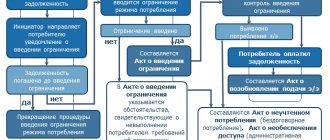The annual increase in electricity prices raises many questions among residents of apartment buildings. To answer them, the management organization, being the provider of the utility service for energy supply, must know about the groups of tariffs and their components that affect price increases. Let's talk about this today.
Concluding an energy supply agreement based on the one-stop-shop principle
89760
Who sets tariffs for the population
The amount of electricity consumed is measured in kilowatt-hours or kWh. One kWh is the amount of energy consumed by a one-kilowatt (1000 W) device in one hour. For example, a boiler with a power of 3500 W (3.5 kW) consumes 3.5 kW*h per hour of operation, and 7 kW*h in two hours.
The cost of 1 kilowatt-hour is called a tariff. It is formed in accordance with the “Methodological guidelines for calculating regulated tariffs and prices for electric (heat) energy in the retail (consumer) market”, approved by order of the Federal Tariff Service of the Russian Federation dated August 6, 2004 No. 20-e/2.
The price of 1 kWh for an individual resource consumer depends on the tariff group to which it belongs. According to clause 1.1 of Order No. 303-e of the Federal Tariff Service of the Russian Federation dated June 24, 2011, owners of residential premises in apartment buildings and providers of utility services are included in the group “population and equivalent categories” (tariff for the population).
Consumers in this group spend electrical energy for household needs, and not to make a profit. Based on the price of a kilowatt-hour for the population, the payment for the resource consumed for the maintenance of the common property of the owners of apartment buildings is also calculated.
Some non-residential premises also belong to the “population” group - these are premises of a domestic nature, for example, private garages, bathhouses, sheds and cellars. It does not matter who the owner of the non-residential premises is - an individual or a legal entity.
Non-residential premises that are used for commercial purposes (pharmacies, offices, shops, salons, etc.) are included in the tariff group “other consumers” (Article 27, Section VI of the Appendix to Order No. 20-e/2 of the Federal Tariff Service of the Russian Federation). Prices for “other consumers” differ markedly from the cost of a kilowatt-hour for the population.
Tariffs for the population, according to Art. Section 2 I Appendix to the order of the FTS of the Russian Federation No. 20-e/2, establishes the local executive authority in the field of state regulation of tariffs. For example, the Committee on Prices and Tariffs or the Regional Energy Commission. When determining the cost of a kilowatt-hour for the next calendar year, the tariff commission cannot go beyond the range established for each region by the Federal Antimonopoly Service of the Russian Federation.
Grounds for early revision of utility tariffs
142280
Amount of the guarantee supplier's sales premium
A guaranteed supplier earns from a sales premium, which is set by the service according to the tariffs of your region.
According to Decree of the Government of the Russian Federation No. 877 of November 4, 2011, the sales markup is the only official source of income for the guaranteeing supplier.
The sales markup includes the costs of the guaranteeing supplier
- for servicing consumers of electrical energy and
- to service bank loans aimed at bridging cash gaps.
As a rule, the sales markup ranges from 5% to 10% of the final cost of electricity.
Sales premiums are different in each region, since the number of consumers and the volume of their consumption differs from region to region.
As a rule, the smaller the region and the fewer consumers there are, the higher the sales premium.
We will reduce your energy costs by 5% - 30%
Find out in detail
You can find out the size of the sales premium on the website of your guaranteeing supplier in the section for legal entities.
The sales premium changes every year, and sometimes every six months.
Important nuance:
The sales markup of the supplier of last resort depends on the maximum power of the consumer. The higher the maximum power, the lower the sales premium.
What is maximum power and how it is calculated can be found here.
- If the maximum power of your organization is less than 670 kW, you have the maximum amount of sales allowance.
- If the maximum power of your organization is from 670 kW to 10 MW, your sales premium should be approximately 2 times lower.
- The lowest sales premium is for enterprises whose maximum capacity is more than 10 MW.
In order to check whether you are paying correctly, you need to check the amount of the sales surcharge in your electricity bill with the data published on the website of the guaranteeing supplier.
There are cases when these amounts do not “beat”.
And even more often, there are cases when there are several contracts with one consumer, in each of which only part of the maximum power is indicated.
Accordingly, the maximum power of the consumer is divided into 2 or 3 parts.
The consumer will be placed in a lower category and pay the maximum sales premium.
What types of electricity tariffs exist?
Clause 2 of the Decree of the Government of the Russian Federation dated December 7, 1998 No. 1444 and Art. Section 27 II Appendices to Order No. 20-e/2 of the Federal Tariff Service of the Russian Federation divide the population into two tariff subgroups:
- Rural and living in houses with stationary electric stoves.
- The rest of the population is urban and lives in houses with gas stoves.
According to clause 2 of RF PP No. 1444, when determining the price for 1 kWh for the first group of consumers, a reduction factor of 0.7 (- 30%) is applied to the tariff of the second group established by the executive authority. For example, with a price for the urban population of 3.26 rubles/kWh, the cost of a kilowatt-hour for the rural population and those living in houses with electric stoves is 2.28 rubles.
In accordance with Art. Section 7 II Appendix to the order of the FTS of the Russian Federation No. 20-e/2 the tariff can be:
- Single (single-rate).
The cost of a kilowatt-hour does not depend on the time of day - the entire volume is calculated at one price.
- Differentiated by two zones of the day (two-zone, day/night).
The volume of consumption is recorded separately from 07:00 to 23:00 (daytime), from 23:00 to 07:00 (night). The price of electricity consumed at night is significantly lower than the cost of kWh during the day.
- Differentiated by three zones of the day (peak, half-peak, night).
Consumption is taken into account separately at night (from 23:00 to 07:00), as well as during peak time (from 07:00 to 09:00, from 17:00 to 20:00) and during “half-peak” (from 09:00: 00 to 17:00, from 20:00 to 23:00 hours).
For example,
The last two types of tariffs are applied only if the consumer has a multi-tariff metering device established in accordance with Federal Law dated November 23, 2009 No. 261-FZ, Decree of the Government of the Russian Federation dated May 6, 2011 No. 354, Order of the Ministry of Industry and Trade of the Russian Federation dated January 21, 2011 No. 57, etc. .
Examples of approved tariff schedules for the population can be seen in the decrees and orders of regional executive authorities:
- Resolution of the Committee on Prices and Tariffs of the Khabarovsk Territory dated December 19, 2017 No. 38/5,
- Order of the regional energy commission of the Department of Prices and Tariffs of the Krasnodar Territory dated December 19, 2017 No. 60/2017-e,
- Order of the Ministry of Energy and Housing and Communal Services of the Samara Region dated December 14, 2017 No. 736.
Instructions: how to conclude a resource supply agreement for non-residential premises
363382
The right price category for electricity
Choosing the right electricity price point can significantly reduce your energy costs.
There are six price categories in total.
When concluding an energy supply contract with a guaranteeing supplier, if you have not chosen anything, you will automatically be
- first price if your connected power is less than 670 kW and
- into the third price category if your connected power is more than 670 kW.
These price categories are not always optimal for your organization.
The guaranteeing supplier does not care what price category you pay; his profit does not depend on it.
Choosing a price category is the responsibility of the consumer.
Brief description of each price category:
In the 1st category consumer
- pays for consumption according to the meter, and
- the cost of electricity, capacity and transmission services are included in a single tariff.
The first price category may be beneficial for small consumers who work the day shift.
In the 2nd price category, the cost of electricity, capacity and transmission services are also included in the tariff, but this tariff varies by day zone:
- during the day - expensive
- at night - cheap.
The second price category is suitable for organizations that work mainly on night shifts.
In the 3rd price category, the consumer pays separately for consumed electricity, power and transmission services.
As a rule, the cost of electricity in the third price category is cheaper than in the first.
The third price category is suitable for organizations that work one shift.
In the 4th price category, the consumer pays separately for consumed electricity, capacity and a two-rate tariff for transmission services.
The fourth price category is ideal for organizations with a 24-hour and stable work schedule.
The 5th and 6th price categories are the same 3rd and 4th, with only one difference:
In the fifth and sixth price categories, the consumer is required to plan hourly electricity consumption a day in advance.
For deviations from the plan, you have to pay.
If the consumer falls into the plan, the price for the 5th and 6th categories is 5% -7% lower than for the 3rd and 4th.
The fifth and sixth electricity categories are only suitable for organizations that can plan well.
Here we describe in detail how to correctly calculate and choose the price category of electricity.
In addition to choosing a price category, to reduce the cost of electricity, large consumers have the opportunity to switch from a supplier of last resort to an independent energy sales company.
How independent energy sales companies work and why switching to them can be profitable will be discussed in the next section.
What parts make up the tariff for the population?
Regardless of the type, the tariff for the population consists of four parts (Article 10, Section III of the Appendix to Order of the FTS of the Russian Federation No. 20-e/2). The structure is dictated by the resource supply process: electricity is a) produced, b) bought and sold, c) delivered to the end consumer, d) the whole process is regulated by infrastructure organizations.
Let's talk about each component of the tariff in more detail:
1. The cost of producing the resource.
The tariff includes the cost of a kilowatt-hour of electricity from the manufacturer (hydroelectric power station, state district power station, thermal power plant, etc.), which sells it on the wholesale market at free prices.
2. Price of electricity transmission services.
Electricity is delivered from manufacturing companies to the end consumer by network organizations. They, by right of ownership or on other legal grounds, own power grid facilities: power lines, transformer substations, distribution points, etc. (Article 3, Chapter 1 of the Federal Law of March 26, 2003 No. 35-FZ “On Electric Power Industry”).
3. Sales premium (about 5% of the total cost of 1 kWh).
Sales companies buy electricity from producers and then sell it to end consumers under energy supply contracts. Therefore, the tariff includes a sales allowance - funds that are necessary for the sales company (RSC) to operate: pay wages, create a material and technical base, maintain service offices, etc.
The size of the sales allowance is determined by the executive authority based on the calculation of economically justified expenses provided by sales companies (Section IV of the Appendix to Order No. 20-e/2 of the Federal Tariff Service of the Russian Federation).
4. Infrastructure payments (about 1% of the total cost of 1 kWh).
This is the cost of services of organizations responsible for managing the Unified Energy System of Russia and regulating the electricity market: JSC Center for Financial Settlements, JSC Trading System Administrator and JSC System Operator of the Unified Energy System, etc.
Components of the cost of 1 kWh at a price of 2.26 rubles/kWh:
Procedure for paying for electricity: is it legal to demand an advance?
1070700
Scheme of operation of the retail electricity market
In order to understand how the retail electricity market works, you need to start with the wholesale market.
On the wholesale market, electricity producers sell electricity to energy sales companies and large enterprises at market prices:
Next, energy sales companies resell electricity to end buyers - legal entities and the public.
Why does the electricity tariff increase every year?
To answer this question, you need to remember the components of the electricity tariff:
- The tariff includes the price for the resource from manufacturers. The rise in the cost of its production entails an increase in the cost of a kilowatt-hour for consumers.
- The deterioration of the electrical grid leads to an increase in electricity losses in the networks and requires significant investments for their repair on the part of network companies. The costs of work on electrical networks are increasing - the cost of transporting electricity, which is included in the tariff, is growing. And if the networks are not repaired, emergency power outages will occur.
Knowing the main theses of legislation in the field of tariff setting and the tariff structure, the provider of utility services for energy supply can explain to residents of apartment buildings the reasons for the increase in the price of electricity and the specifics of using one or another type of tariff in calculations.
Guarantee supplier – sales company
Your interaction with the retail electricity market occurs through an energy sales company - a supplier of last resort.
A supplier of last resort is a company that “guarantees” the sale of electricity in your region.
The supplier of last resort is obliged to conclude an electricity sales agreement with each consumer who contacts him.
Each guaranteeing supplier has its own area of responsibility, determined by government agencies.
The supplier of last resort is obliged to enter into electricity sales agreements only with consumers located in its area of responsibility.
The supplier of last resort receives this practically monopoly right to sell electricity on the basis of a competition.
But the rules of the competition are such that practically the same guaranteed supplier constantly wins the competition and receives the exclusive right to sell electricity.
The main function of the supplier of last resort is to collect money from consumers in a timely manner and distribute it to other participants in the electricity market - grid companies and electricity producers.
If a supplier of last resort collects money poorly from consumers, it quickly falls into financial difficulties and goes down the drain - losing its monopoly position.
Another energy sales company is appointed in its place.
Now let's see how much and what the guaranteeing supplier earns and what nuances you need to pay attention to.
Electricity producers
The main players in the retail electricity market are, of course, electricity producers.
Electricity producers with an installed capacity of more than 25 MW are required to sell electricity and capacity on the wholesale electricity market.
Power producers with installed capacity of less than 25 MW sell electricity through the retail electricity and capacity market.
In some cases, the cost of electricity from small producers may be lower than from guaranteed suppliers.
Four price zones in Russia
The retail electricity and power market is divided into 4 price zones.
All of the above rules apply only to free price zones in Russia - these are the first and second price zones.
The first and second price zones include the overwhelming majority of Russian consumers - this is the European part of Russia, the Urals and Siberia.
Here's what it looks like on the map:
In price zones, prices for consumers on the retail electricity market are free.
In the non-price zone and in the isolated zone, prices are set by the state.
It is worth recalling that the division into price (free) and non-price (regulated) zones applies only to legal entities.
The population always pays regulated prices set by the state.
We will reduce your energy costs by 5% - 30%
Benefits for paying for electricity in the Russian Federation
There is no single law regulating privileges when paying for electricity. Categories of beneficiaries are established by various regulations at the federal and regional levels.
Benefits for electricity
All-Russian benefits:
- complete exemption from paying utility bills - full holders of the highest awards of the Soviet Union and Russia;
- 60% discount - family members of deceased military personnel;
- 50% — people with disabilities, families with disabled children, WWII veterans, liquidators and victims of the Chernobyl disaster.
Regional authorities have the right to supplement the federal list of beneficiaries at their discretion. Often preferences in subjects are based :
- large families;
- persons of retirement age;
- low-income citizens;
- labor veterans;
- home front workers;
- honorary donors.
You can check the availability of privileges in the desired subject of Russia with the social protection authorities. Benefits are provided provided that the payer has no debts on payment for electricity.











